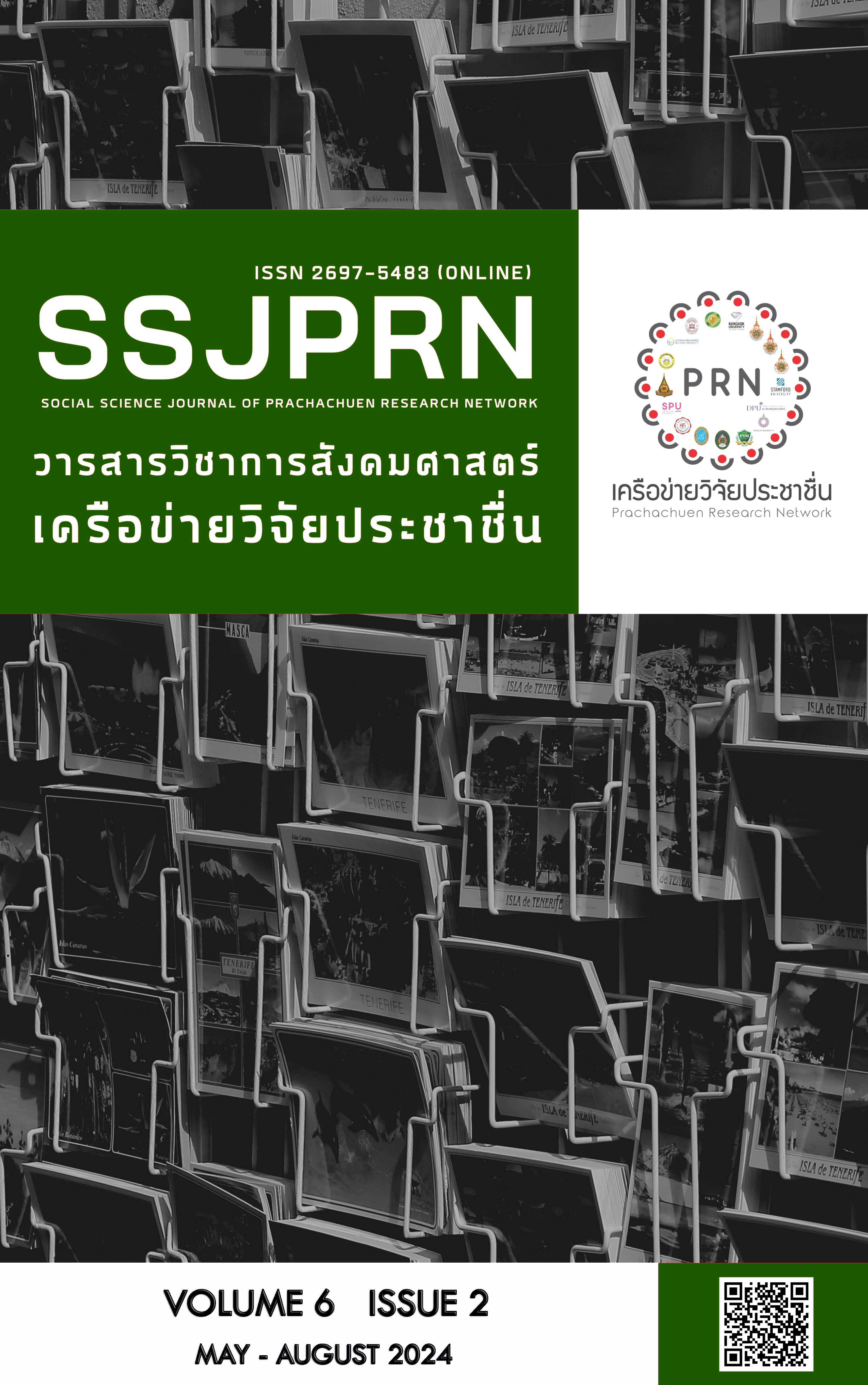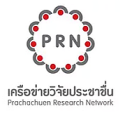ปัจจัยที่มีผลต่อการจัดการขยะสกินแคร์และเครื่องสำอางของผู้บริโภค ในกรุงเทพมหานคร ประเทศไทย
คำสำคัญ:
สกินแคร์, เครื่องสำอาง, ขยะจากสกินแคร์, การจัดการขยะ, อุตสาหกรรมเครื่องสำอางบทคัดย่อ
การวิจัยครั้งนี้มีวัตถุประสงค์เพื่อศึกษาปัจจัยที่มีผลต่อการจัดการขยะสกินแคร์และเครื่องสำอางของผู้บริโภคในกรุงเทพมหานคร โดยการวิจัยเรื่องนี้เป็นการวิจัยเชิงปริมาณ ใช้วิธีการสำรวจโดยใช้แบบสอบถามเป็นเครื่องมือในการเก็บข้อมูล กลุ่มตัวอย่าง คือ ผู้บริโภคสกินแคร์และเครื่องสำอางที่อาศัยอยู่ในกรุงเทพมหานคร จำนวน 400 คน สถิติเชิงพรรณนาที่ใช้ในการวิเคราะห์ข้อมูลเชิงปริมาณ ได้แก่ ค่าความถี่ ค่าร้อยละ ค่าเฉลี่ยและค่าส่วนเบี่ยงเบนมาตรฐาน สถิติเขิงอนุมานที่ใช้ในการทดสอบสมมติฐาน คือ วิเคราะห์การทดสอบสมมติฐานโดยการวิเคราะห์การถดถอยเชิงเส้นแบบพหุ
ผลการวิจัย พบว่า ความรู้ การตระหนักรู้ถึงปัญหา ทัศนคติ และสิ่งจูงใจจากผู้ผลิต มีผลเชิงบวกต่อความตั้งใจในการจัดการขยะสกินแคร์และเครื่องสำอางอย่างมีนัยสำคัญทางสถิติที่ระดับ .05 ในขณะเดียวกัน นโยบายภาครัฐ และสิ่งอำนวยความสะดวกที่รับรู้ มีผลเชิงบวกต่อความตั้งใจในการจัดการขยะสกินแคร์และเครื่องสำอางอย่างมีนัยสำคัญทางสถิติที่ระดับ .001 และการวิจัยครั้งนี้ยังพบว่า ผู้บริโภคยังขาดความรู้และการตระหนักรู้ในการจัดการขยะในบางเรื่อง แต่ในทางกลับกัน ผู้บริโภคมีทัศนคติเกี่ยวกับการจัดการขยะที่ดีมาก ดังนั้น หากมีสิ่งจูงใจจากผู้ผลิตและนโยบายภาครัฐที่มีการจัดทำแผนเพื่อแก้ไขปัญหาขยะอย่างมีประสิทธิภาพ จะช่วยส่งเสริมให้ผู้บริโภคมีความตั้งใจในการจัดการขยะจากสกินแคร์และเครื่องสำอางมากยิ่งขึ้น
เอกสารอ้างอิง
พีรนาฏ คิดดี, โสมศิริ เดชารัตน์ และ สุทธิพร บุญมาก. (2566). ปัจจัยที่ส่งผลต่อการจัดการขยะอิเล็กทรอนิกส์ในจังหวัดชายแดนภาคใต้. Life Sciences and Environment Journal, 24(1), 100-110.
วันวิสาข์ คงพิรุณ, สรัญญา ถี่ป้อม และ วิโรจน์ จันทร. (2560). ปัจจัยที่มีผลต่อพฤติกรรมการจัดการขยะในหมู่บ้านโป่งปะ ตําบลแก่ง โสภา อําเภอวังทอง จังหวัดพิษณุโลก. วารสารวิทยาศาสตร์สุขภาพแห่งประเทศไทย, 26(2), 310-321.
วิรุทธิ์ เอี่ยมสหเกียรติ และ วิราสิริริ์ วสีวีรสิว์. (2565). ปัจจัยที่มีอิทธิพลต่อพฤติกรรมการจัดการขยะมูลฝอย ของผู้ค้าหาบเร่แผงลอย เขตราชเทวี กรุงเทพมหานคร. วารสารมหาจุฬานาครทรรศน์, 9(2), 277-289.
Abou Taleb, M., & Al Farooque, O. (2021). Towards a circular economy for sustainable development: An application of full cost accounting to municipal waste recyclables. Journal of Cleaner Production, 280, 124047.
Ajzen, I. (1985). From intentions to actions: A theory of planned behavior. In Action control: From cognition to behavior (pp. 11-39). Springer Berlin Heidelberg.
Ajzen, I., & Madden, T. J. (1986). Prediction of goal-directed behavior: Attitudes, intentions, and perceived behavioral control. Journal of Experimental Social Psychology, 22(5), 453-474.
Bolderdijk, J. W., & Steg, L. (2015). Promoting sustainable consumption: The risks of using financial incentives. In Handbook of research on sustainable consumption (pp. 328-342). Edward Elgar.
Cochran, W. G. (1953). Sampling techniques. John Wiley.
De, S. K., Kawdia, P. (2023). Packaging plastic waste management in the cosmetic industry. Management of Environmental Quality: An International Journal, 34(3), 820-842.
Elia, V., Gnoni, M. G., & Tornese, F. (2015). Designing Pay-As-You-Throw schemes in municipal waste management services: A holistic approach. Waste Management, 44, 188-195.
EVA. (2018). Containers and Packaging: Product-Specific Data. https://www.epa.gov/facts-and-figures-about-materials-waste-and-recycling/containers-and-packaging-product-specific
Fishbein, M., & Ajzen, I. (1975). Belief, attitude, intention, and behavior: An introduction to theory and research. Addison-Wesley.
Fortune Business Insight. (2023). Cosmetics Market Size, Share & Industry Analysis, By Category. https://www.fortunebusinessinsights.com/cosmetics-market-102614
Gusti, A. (2016). The relationship of knowledge, attitudes, and behavioral intentions of sustainable waste management on primary school students in city of Padang, Indonesia. International Journal of Applied Environmental Sciences, 11(5), 1323-1332.
Hu, H., Zhang, J., Chu, G., Yang, J., & Yu, P. (2018). Factors influencing tourists’ litter management behavior in mountainous tourism areas in China. Waste management, 79, 273-286.
Ittiravivongs, A. (2012). Factors influence household solid waste recycling behaviour in Thailand: an integrated perspective. WIT Trans Ecol Environ, 167, 437-448.
Li, J., Zuo, J., Cai, H., & Zillante, G. (2018). Construction waste reduction behavior of contractor employees: An extended theory of planned behavior model approach. Journal of Cleaner Production, 172, 1399-1408.
Mahanakorn partners group. (2022). A Beautiful Opportunity? – A Review of The Cosmetics Industry in Thailand. https://mahanakornpartners.com/a-beautiful-opportunity-a-review-of-the-cosmetics-industry-in-thailand/
Maki, A., Burns, R. J., Ha, L., & Rothman, A. J. (2016). Paying people to protect the environment: A meta-analysis of financial incentive interventions to promote proenvironmental behaviors. Journal of Environmental Psychology, 47, 242-255.
McAllister, J. (2015). Factors influencing solid-waste management in the developing world. https://digitalcommons.usu.edu/gradreports/528
Park, S. (2018). Factors influencing the recycling rate under the volume-based waste fee system in South Korea. Waste Management, 74, 43-51.
Savalei, V., & Bentler, P. M. (2005). A Statistically Justified Pairwise ML Method for Incomplete Nonnormal Data: A Comparison with Direct ML and Pairwise ADF. Structural Equation Modeling, 12(2), 183-214.
Seacat, J. D., & Boileau, N. (2018). Demographic and community-level predictors of recycling behavior: A statewide, assessment. Journal of Environmental Psychology, 56, 12-19.
Skumatz, L. A. (2008). Pay as you throw in the US: Implementation, impacts, and experience. Waste Management, 28(12), 2778-2785.
Starr, J., & Nicolson, C. (2015). Patterns in trash: Factors driving municipal recycling in Massachusetts. Resources, Conservation and Recycling, 99, 7-18.
Suphasomboon, T., & Vassanadumrongdee, S. (2023). Multi-stakeholder perspectives on sustainability transitions in the cosmetic industry. Sustainable Production and Consumption, 38, 225-240.
Timlett, R. E., & Williams, I. D. (2008). Public participation and recycling performance in England: A comparison of tools for behaviour change. Resources, Conservation and Recycling, 52(4), 622-634.
Vorobeva, D., Scott, I. J., Oliveira, T., & Neto, M. (2022). Adoption of new household waste management technologies: The role of financial incentives and pro-environmental behavior. Journal of Cleaner Production, 362, 132328.
Wang, S., Ji, C., He, H., Zhang, Z., & Zhang, L. (2021). Tourists’ waste reduction behavioral intentions at tourist destinations: An integrative research framework. Sustainable Production and Consumption, 25, 540-550.
Wang, S., Li, J., & Zhao, D. (2017). The impact of policy measures on consumer intention to adopt electric vehicles: Evidence from China. Transportation Research Part A: Policy and Practice, 105, 14-26.
Wang, S., Wang, J., Yang, S., Li, J., & Zhou, K. (2020). From intention to behavior: Comprehending residents’ waste sorting intention and behavior formation process. Waste Management, 113, 41-50.
Yuan, K.-H., & Bentler, P. M. (2000). 5. Three Likelihood-Based Methods for Mean and Covariance Structure Analysis with Nonnormal Missing Data. Sociological Methodology, 30(1), 165-200.
Zhang, B., Lai, K. H., Wang, B., & Wang, Z. (2019). From intention to action: How do personal attitudes, facilities accessibility, and government stimulus matter for household waste sorting? Journal of Environmental Management, 233, 447-458.
ดาวน์โหลด
เผยแพร่แล้ว
รูปแบบการอ้างอิง
ฉบับ
ประเภทบทความ
สัญญาอนุญาต
ลิขสิทธิ์ (c) 2024 วารสารวิชาการสังคมศาสตร์เครือข่ายวิจัยประชาชื่น

อนุญาตภายใต้เงื่อนไข Creative Commons Attribution-NonCommercial-NoDerivatives 4.0 International License.
บทความที่ได้รับการตีพิมพ์เป็นลิขสิทธิ์ของวารสารวิชาการสังคมศาสตร์เครือข่ายวิจัยประชาชื่น







